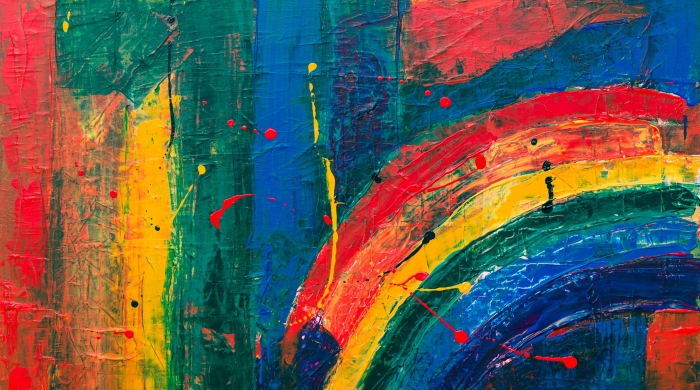
On Friday, April 24, students from across the country will participate in the 24th annual Day of Silence, a national student-led event where individuals take a vow of silence to highlight the silencing and erasure of lesbian, gay, bisexual, transgender, and queer (LGBTQ) people at school. This annual day of action unites LGBTQ people and advocates across the country and centers its power in non-violent student protest.
As schools across the country are closing, some for an unforeseen amount of time, the Day of Silence is going digital this year. There are still ways to build connections online and share powerful messages while participating in social distancing. For example, posting about the Day of Silence on social media is one way to spread the word about the experiences of LGBTQ youth in schools. GLSEN, the leading education organization working to create safe and inclusive schools for LGBTQ students, is hosting a Virtual “Breaking the Silence Rally” on their Instagram page at 3 pm EST. Despite the new format in 2020, the silence the event marks remains all too entrenched.
“They told me it’s ‘too gay,’” said Janet*, the adult advisor of the Gay-Straight Alliance (GSA; also sometimes called a Gender and Sexuality Allliance) at a high school on Staten Island. She was referring to last year’s club t-shirt design, which is lavender with the school logo outlined in rainbow. Most of the 30 or so members of the club refuse to wear the shirt in school, fearing homophobic comments or other forms of victimization. This is just one of many ways in which LGBTQ students and their allies are silenced in schools.
In U.S. schools, 4 in 5 LGBTQ students don’t see positive LGBTQ representation in their curriculum, 8 in 10 LGBTQ students experience anti-LGBTQ verbal harassment, and over a third miss school because they feel unsafe or uncomfortable. All students deserve a safe and affirming learning environment. School leaders must take action to be more inclusive.
What can school administrators do to “break the silence” all year long?
- Promote comprehensive anti-bullying policies that include sexual orientation and gender identity/expression as protected characteristics and encourage bystander intervention in bias-based bullying. When teachers and peers are not intervening in this kind of harassment, it sends the message that it’s okay for the harasser (and others) to behave this way.
- Require teacher and staff training on supporting LGBTQ youth and families. Professional development should be offered to educators on creating LGBTQ-inclusive spaces at school. When LGBTQ students can name many supportive educators at their school, they also report higher GPAs and a greater sense of belonging to the school community.
- Incorporate inclusive curriculum that includes representation of LGBTQ issues and people in ALL subjects. LGBTQ students in schools with LGBTQ-inclusive curriculum report that their peers are more accepting of LGBTQ people and are less likely to miss school due to feeling unsafe or uncomfortable. It is important that LGBTQ students see themselves represented in class and that everyone learns that diverse experiences add to the vibrancy of our nation’s schools and our society.
- Combat gender and sexual orientation and gender identity (SOGI) biases/stereotypes that limit true representation of academic (and future career) interests and aspirations. Forthcoming research finds that LGBTQ students who live in counties that hold more gender-subject stereotypical views are more likely to pursue gender-atypical majors. Put more simply, stereotypes aligning men with science and math and women with English yield queer men choosing more female-dominated majors and queer women choosing more male-dominated majors. Perceiving LGBTQ students as a monolith further limits their ability to flourish in pursuing their true interests.
- Support Gender and Sexuality Alliances in their advocacy at the school and community level. Approximately 37% of schools across the United States have a Gay-Straight Alliance or similar club. Research shows that LGBTQ students in schools with a GSA report hearing fewer anti-LGBTQ remarks and feeling safer at school. The Equal Access Act is a federal law which requires that a public school allow a GSA if that school allows the formation of other non-curricular student clubs.
Following the civil rights era, new legislation required that all states must provide children access to equal educational opportunities, ending de jure segregation based on gender, race, color, nationality, and disability. While these pieces of legislation set the foundation for a fairer school system, sexual- and gender-minority youth were missing from the protected groups. As American attitudes, laws, and schools have evolved over the past half-century, education as an institution, now more than ever, has a responsibility to both provide LGBTQ students with equal learning opportunities and also promote environments where queer students can flourish equally alongside their peers.
We need your commitment to breaking the silence and creating a school community inclusive of LGBTQ students. Visit GLSEN's website to download free resources, lesson plans, and toolkits to create safer and more inclusive K-12 schools, including how to organize a Virtual Day of Silence.
Sarah Rosenbach (she/her/hers) is a Ph.D. student and an Institute for Education Sciences Predoctoral Interdisciplinary Research and Training fellow at NYU Steinhardt. In addition, Sarah is currently interning in the research department at GLSEN, a national nonprofit that works to ensure safe schools for all students, regardless of sexual orientation and gender identity. Her research focuses on the ways in which school policies, practices, and peers can support the healthy development of LGBTQ adolescents. Follow her on Twitter @sarahrosenbach.
Zachary T. McDermott (he/him/his) is a 3rd-year Ph.D. student in Education Policy at NYU Wagner and a 3rd-year PIRT fellow. His broad interests focus on using quantitative methodology in education policy research, with an aim to identify and understand inequity for disadvantaged populations, specifically LGBTQ+ and gender minorities, persons with disabilities, and racial/ethnic minorities. Specific to the SOGI population, one current project is exploring what differentially explains college major and career decisions by gender and sexual orientation. Follow him on Twitter @zac_mcdermott.
Recommended Reading
Poteat, V. P., Calzo, J. P., Yoshikawa, H., Lipkin, A., Ceccolini, C. J., Rosenbach, S. B., ... & Burson, E. (2019). Greater Engagement in Gender‐Sexuality Alliances (GSAs) and GSA Characteristics Predict Youth Empowerment and Reduced Mental Health Concerns. Child development
Poteat, V. P., Calzo, J. P., Yoshikawa, H., Rosenbach, S. B., Ceccolini, C. J., & Marx, R. A. (2019). Extracurricular Settings as a Space to Address Sociopolitical Crises: The Case of Discussing Immigration in Gender-Sexuality Alliances Following the 2016 US Presidential Election. American Educational Research Journal56(6), 2262-2294.
Poteat, V. P., Calzo, J. P., Yoshikawa, H., Miller, S. J., Ceccolini, C. J., Rosenbach, S., & Mauceri, N. (2018). Discussing transgender topics within gay-straight alliances: Factors that could promote more frequent conversations. International Journal of Transgenderism, 19(2), 119-131.


